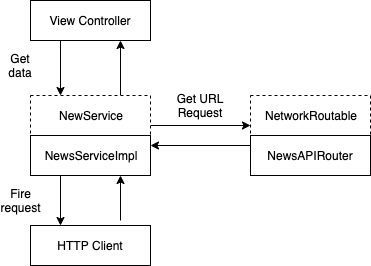The app is a news browser app, it has 2 screens - feed and detail, and uses News API to get data about news.
The following sections discuss the architecture of different layers of the app
Networking module consists of multiple layers stacked together
The deepest layer is HTTPClient which has access to URLSession which is used to fire requests. URLSession here may be swapped with any other network provider, for example, Alamofire. This class has only one generic function which fires the request (URLRequest) and returns Result with decoded object or error in a callback
The next layer is Service (in this case, only NewsService), which accesses HTTPClient and passes there URLRequest. This layer is a high-level interface for any networking client in the app. The service is exposed as protocol so that it can be mocked. It uses NetworkRoutable to build an actual URL request
NetworkRoutable is the main building block of the URL request. It's a protocol, which defines the interface for endpoint models, and in turn, has a default implementation for URLRequestConvertible to provide actual URLRequest. In this case, there's one endpoint model - NewsAPIRouter. It is an enum with cases for all the needed API methods. The enum conforms to NetworkRoutable and provides all the data needed to build URLRequest
All the above can be illustrated with the following diagram:
The app uses coordinator pattern for navigation
A coordinator is an entity which controls the navigation flow in the app. Generally speaking, each distinct linear flow should have a distinct coordinator. Coordinators are then arranged in the hierarchical tree-like order with the root in the AppCoordinator, which decides the flow when the app starts. In this case, the app has only one coordinator - AppCoordinator
Coordinators conform to Coordinatable protocol so that they can be stored as dependencies in other coordinators and have a concise interface. Usually, a coordinator has 2 dependencies - factories for building other coordinators and flow-related views, CoordinatorFactory and ModuleFactory correspondingly
Coordinators don't access UIKit-specific controller and instead use NavigationRoutable to perform actual navigation. It's a protocol, which provides an interface for navigation. In this app it has 2 implementations - NavigationRouter and SplitRouter for navigation using UINavigationController and UISplitViewController correspondingly.
All the above can be illustrated with the following diagram:
The architecture used and described above may be seen as overkill for such a small app - there's more boilerplate code than "real" code. However, my assumption is that the code test is used to assess my skills working on a bigger project, where this architecture makes more sense
I don't use any dependencies here on purpose, as want do make pure solution. But if I wanted, I would use:
- Alamofire - for more extensive networking
- KingFisher - for image downloading

